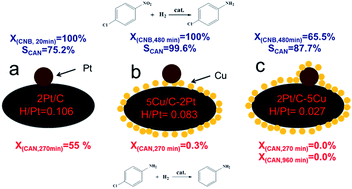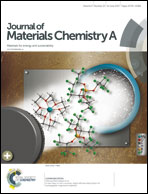Deficient copper decorated platinum nanoparticles for selective hydrogenation of chloronitrobenzene†
Abstract
Two types of model Pt–Cu catalysts are designed and prepared to explore the contribution of the geometric and electronic effects from copper to the catalytic performance of Pt nanoparticles in the selective hydrogenation of p-chloronitrobenzene (p-CNB). One model Pt–Cu catalyst (called Cu/C–Pt) is Pt nanoparticles deposited on ultra-small copper particle-decorated activated carbon, and the other is copper particle-decorated Pt/C catalyst (called Pt/C–Cu). Cu/C–Pt catalyst has an activity lower than that of Pt/C, but the selectivity of the desired product p-chloroaniline (p-CAN) on the Cu/C–Pt catalyst is much higher than that on Pt/C. On the Pt/C–Cu catalyst, p-CNB cannot be completely converted into p-CAN. The dechlorination rates of p-CAN on Cu/C–Pt catalysts are three orders of magnitude lower than that on Pt/C. More interestingly, the dechlorination reaction of p-CAN on Pt/C–Cu cannot be observed. High resolution TEM images of our Pt–Cu catalysts show that Pt nanoparticles keep their crystalline structure after incorporation with copper. The dispersions of Pt in 2Pt/C, 5Cu/C–2Pt, and 2Pt/C–5Cu reach 0.106, 0.083 and 0.027, respectively (the numbers before Pt and Cu represent their percentages), revealing that Pt nanoparticles in Cu/C–Pt have a larger exposed surface than those in Pt/C–Cu. It can be deduced that copper mainly exerts an electronic effect on the catalytic performance of Pt nanoparticles in Cu/C–Pt. On the other hand, the geometric effect on Pt from copper in Pt/C–Cu leads to not only a low dispersion of Pt nanoparticles but a weak activity in catalytic hydrogenation of p-CNB and dechlorination of p-CAN. The interaction between Pt nanoparticles and Cu nanoparticles at room temperature is also discussed.



 Please wait while we load your content...
Please wait while we load your content...